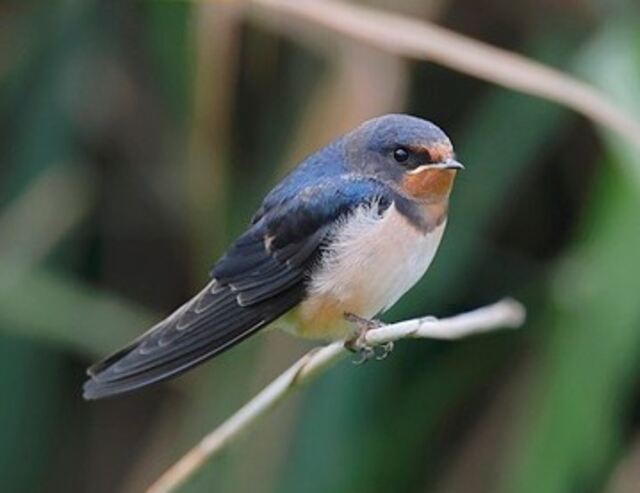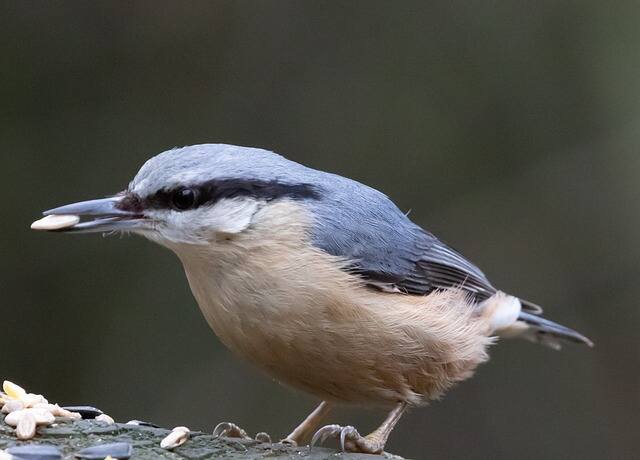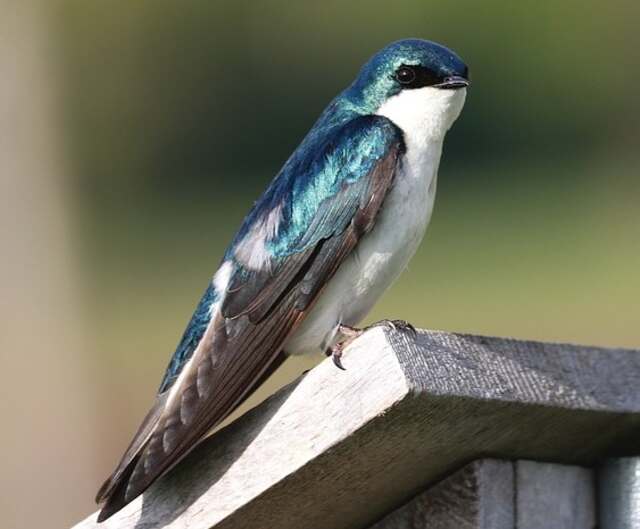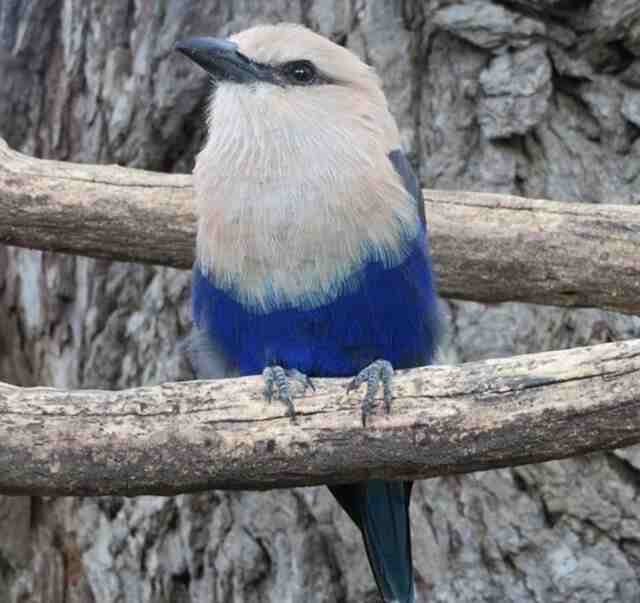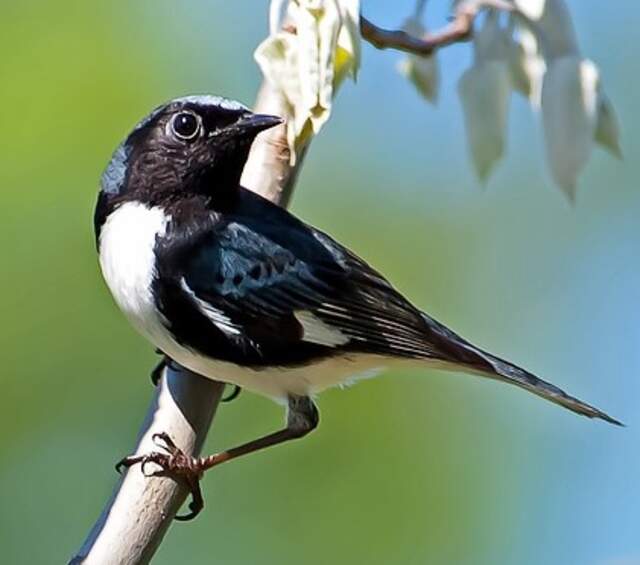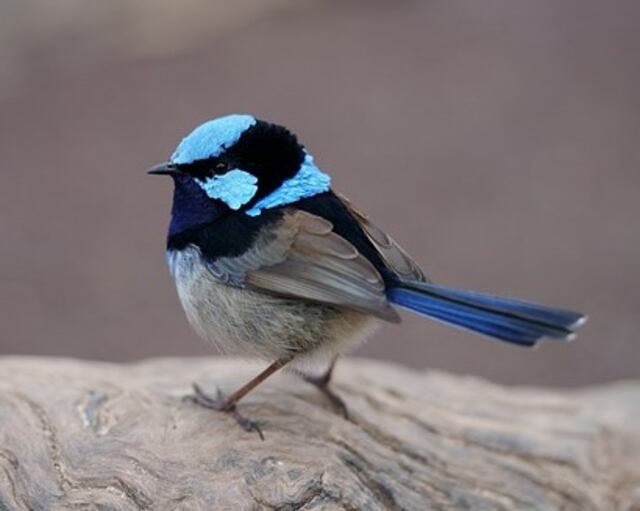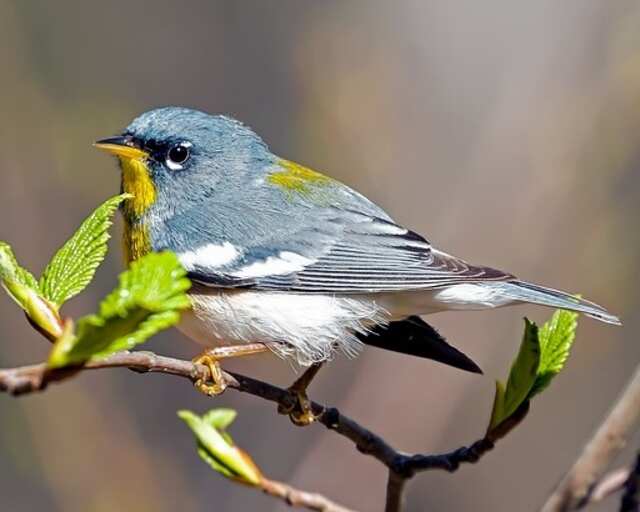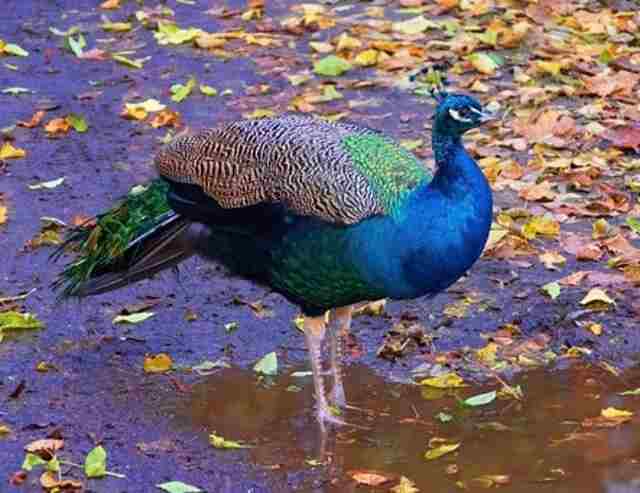Blue birds are a wonder to behold with their strikingly beautiful plumage that ranges from the deepest sapphire to the palest sky blue. These avian gems can be found all over the world, from the tropical forests of South America to the cold tundras of the Arctic.
In this article, we’ll showcase 30 of the most breathtaking blue colored birds that will leave you in awe. So sit back, relax, and enjoy a visual feast of these stunning feathered creatures.
Table of Contents
- 1 Breathtaking Blue Colored Birds
- 1.1 Western Bluebird
- 1.2 Barn Swallow
- 1.3 Lazuli Bunting
- 1.4 Common Kingfisher
- 1.5 Steller’s Jay
- 1.6 Eastern Bluebird
- 1.7 Mountain Bluebird
- 1.8 Blue Jay
- 1.9 Blue Nuthatch
- 1.10 Eurasian Nuthatch
- 1.11 Indigo Bunting
- 1.12 Tree Swallow
- 1.13 Belted Kingfisher
- 1.14 Little Blue Heron
- 1.15 Blue Grosbeak
- 1.16 Superb Starling
- 1.17 Tickell’s Blue Flycatcher
- 1.18 Blue-bellied Roller
- 1.19 Black-throated Blue Warbler
- 1.20 Pale Blue Flycatcher
- 1.21 Indian Roller
- 1.22 Cape Starling
- 1.23 Victoria Crown Pigeon
- 1.24 Satin Bowerbird
- 1.25 Superb Fairywren
- 1.26 Varied Thrush
- 1.27 Orange-bellied Flowerpecker
- 1.28 Northern Parula
- 1.29 Blue Indian Peafowl
- 2 Frequently Asked Questions
- 2.1 What breeds of birds are blue?
- 2.2 What are blue colored birds called?
- 2.3 What kind of bird is royal blue?
- 2.4 What bird looks like a sparrow but is blue?
- 2.5 What is the rarest blue bird?
- 2.6 What is the prettiest blue bird?
- 2.7 What is the beautiful blue bird?
- 2.8 What are the three blue birds called?
- 2.9 What does it mean when a blue bird visits you?
- 2.10 What is a small dark blue bird?
- 2.11 What is the blue bird that looks like a finch?
- 2.12 What bird is large and blue?
- 2.13 Are there blue finches?
- 2.14 What is a small turquoise bird?
- 2.15 How many types of blue birds are there?
- 2.16 What bird is blue with a black head?
- 2.17 Are there any truly blue birds?
- 2.18 What is the blue and gold bird called?
- 2.19 What is the blue bird that looks like a robin?
- 2.20 How rare is a blue finch?
- 2.21 How do I identify a blue bird?
- 2.22 What does a blue mockingbird look like?
- 2.23 What is the blue bird that looks like a crane?
- 2.24 What does a Jaeger bird look like?
- 2.25 What kind of bird is teal in color?
- 2.26 What bird has a bright blue back and red chest?
- 2.27 What does an indigo blue bird look like?
- 2.28 What small bird has a blue crown?
- 2.29 What is an aqua bird?
- 2.30 What is a bluish gray songbird?
- 2.31 What is the most common blue bird?
- 2.32 What birds are often blue?
- 2.33 What color is a female blue bird?
- 2.34 What is a blue bird that looks like a cardinal?
- 2.35 What bird looks like a blue jay but bigger?
- 2.36 What kind of bird looks like a blue jay but is black?
- 2.37 What is the rarest blue bird?
- 2.38 What bird is blue but not a bluebird?
- 2.39 What is a solid blue bird in North America?
- 3 Conclusion
- 4 Author
Breathtaking Blue Colored Birds
Western Bluebird
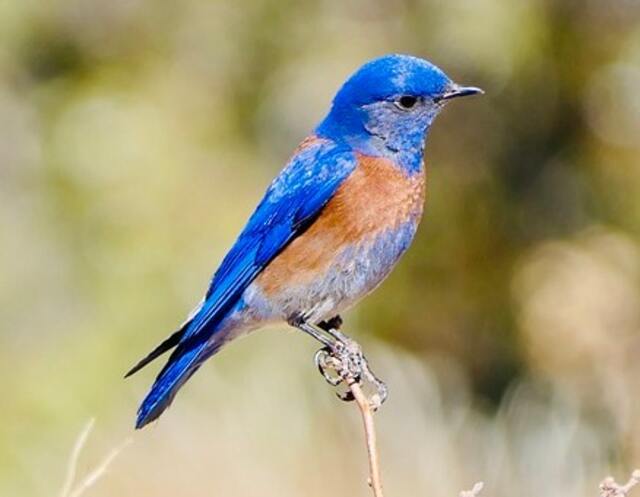
The Western Bluebird, also known by its scientific name Sialia mexicana, is a small, colorful bird native to western North America. It is named after its distinctive blue coloration, which extends from its head to its wings and tail. Male Western Bluebirds have a bright blue plumage, while females have a duller blue-gray coloration. They are characterized by their short, thin bills and white underbellies.
On average, Western Bluebirds measure 15-18 cm in length and have a wingspan of 26-32 cm. They weigh between 27–32 grams. Western Bluebirds are commonly found in open woodland and grassland habitats, often near streams or other sources of water.
Their diet consists primarily of insects and other small invertebrates, but they also consume berries and other fruits when available. Western Bluebirds typically have a lifespan of 5–7 years. They are migratory birds, and during the winter months, they move to warmer areas in the southern part of their range.
Read more: 9 Best Birdhouses for Bluebirds (Our Top Picks for 2023)
Barn Swallow
The Barn Swallow (Hirundo rustica) is a species of bird found across much of the world, known for its distinctive blue and rust-colored plumage. They are characterized by their deeply forked tails, which they use to maneuver through the air with great agility.
On average, Barn Swallows measure around 5-7 inches in length, with an average wingspan of 11–13 inches and an average weight of 15–20 grams. They are often found near human habitation, building their cup-shaped nests on ledges or rafters. Barn Swallows primarily feed on insects, which they catch in flight.
They have a lifespan of around 4–6 years, and are known for their impressive migrations, traveling thousands of miles each year to breed in their summer habitats and winter in warmer climates.
Read more: How to Attract Swallows to my Yard? (The Expert’s Guide)
Lazuli Bunting
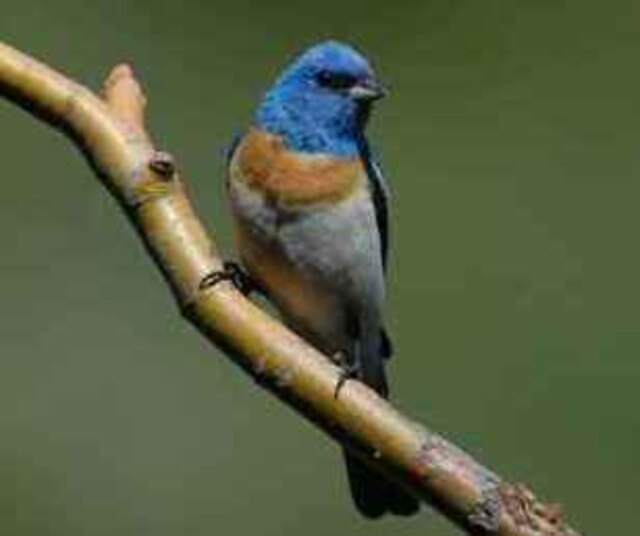
The Lazuli Bunting is a small passerine bird found in North America. Its scientific name is Passerina amoena. The male bird is brightly colored with a blue head, back, and wings, while the belly is brownish-red. The female is mostly brown with a blue tint on the wings and tail.
These birds are known for their sweet and melodious songs. They are also highly active and agile, often seen perching on shrubs and trees. Lazuli Buntings are about 4 to 5 inches long and have an average wingspan of 7 to 9 inches. They weigh around 12 to 15 grams.
Lazuli Buntings prefer to live in open forests, meadows, and gardens. They feed on insects, seeds, and berries. Their lifespan is around 5 to 6 years.
Common Kingfisher
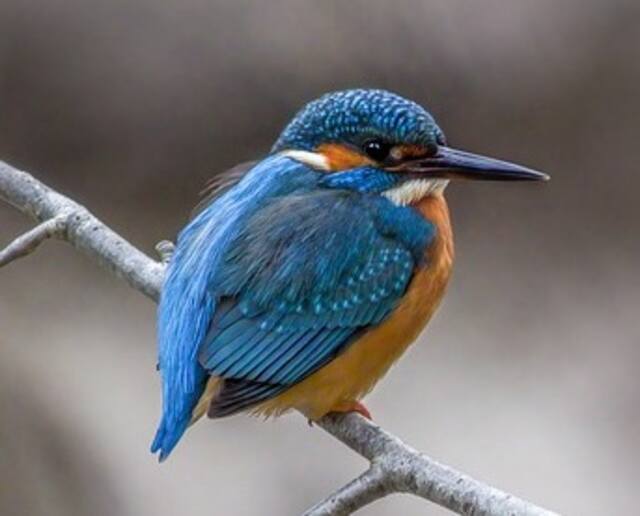
The Common Kingfisher, scientifically known as Alcedo atthis, is a striking bird with its vivid blue and orange coloration. They have a sturdy build, short tail, and large head with a long, pointed bill that is perfectly adapted for catching fish – their primary food source. They measure approximately 16 cm in length, have an average wingspan of 25 cm, and weigh around 40 grams.
Common Kingfishers can be found in various habitats, including rivers, streams, and lakes throughout Asia and Europe. They are skilled hunters, using their sharp eyesight to locate prey before diving into the water to catch fish, insects, and invertebrates.
In the wild, these birds typically live for around 6 years. Unfortunately, they are at risk of habitat loss due to human activities, and poachers often target them for their feathers. It is essential to protect these beautiful creatures and their habitats to ensure their survival.
Steller’s Jay
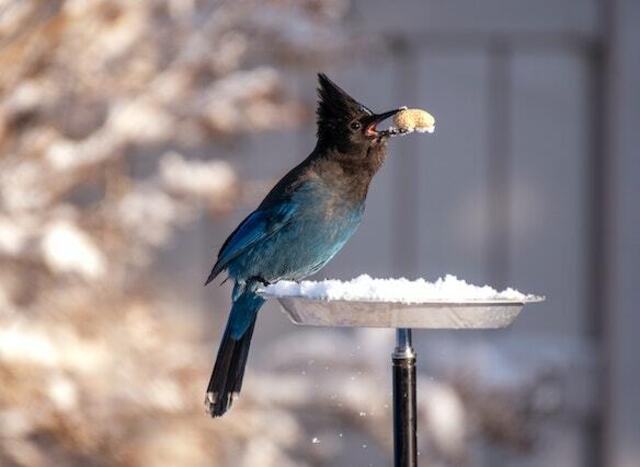
The Steller’s Jay, or Cyanocitta stelleri, is a striking bird with deep blue coloration, a black crest on its head, and bold black markings around its eyes. Their intelligence, adaptability, and vocalizations are notable traits of these birds. They can be found in a variety of habitats, from forests to urban areas, across western North America.
On average, Steller’s Jays are around 30 cm in length with a wingspan of approximately 43 cm. They weigh an average of 100-120 grams and feed on a varied diet of insects, fruits, nuts, and seeds.
Steller’s Jays have a relatively long lifespan, with some individuals living up to 16 years in the wild. They are a beautiful and fascinating species, and a joy to watch in their natural habitat.
Read more: How to Attract Steller’s Jay to your Yard – Expert Tips!
Eastern Bluebird

The Eastern Bluebird, or Sialia sialis, is a small, beautiful bird found in eastern North America. They are known for their stunning blue plumage on their upperparts, contrasting reddish-brown breast, and white belly. These cavity-nesting birds can often be seen perched on fence posts or hovering above open fields searching for insects and berries.
Eastern Bluebirds typically measure around 15 cm in length, with a wingspan of approximately 25 cm, and weigh around 27 grams. Breeding season begins in early spring, during which the female lays 3-7 eggs per clutch.
In the wild, Eastern Bluebirds have a lifespan of around 6 years. Their beauty, melodious song, and charming behavior make them popular among birdwatchers and backyard bird enthusiasts alike.
Read more: How to Attract Eastern Bluebirds to your Yard (Explained)
Mountain Bluebird
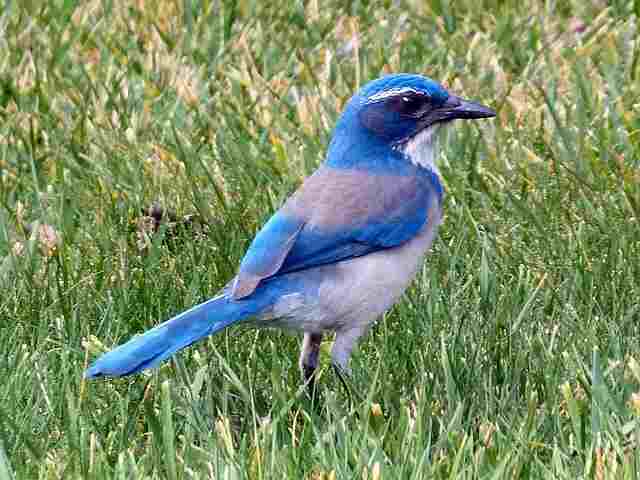
Found in western North America, the Mountain Bluebird (Sialia currucoides) is a small but breathtakingly beautiful bird. These cavity-nesting birds prefer open habitats such as meadows, sagebrush, and mountain slopes. Their diet mainly consists of insects and berries, and they can often be seen perched on fences or utility wires while hunting for food.
Mountain Bluebirds are around 16 cm long, with a wingspan of approximately 32 cm and an average weight of 30 grams. Breeding season begins in spring, during which the female lays 4-7 eggs per clutch.
In the wild, Mountain Bluebirds have a lifespan of around 6 years. With their bright blue upperparts and white underparts, they are a delightful sight to behold for birdwatchers and nature enthusiasts alike.
Blue Jay
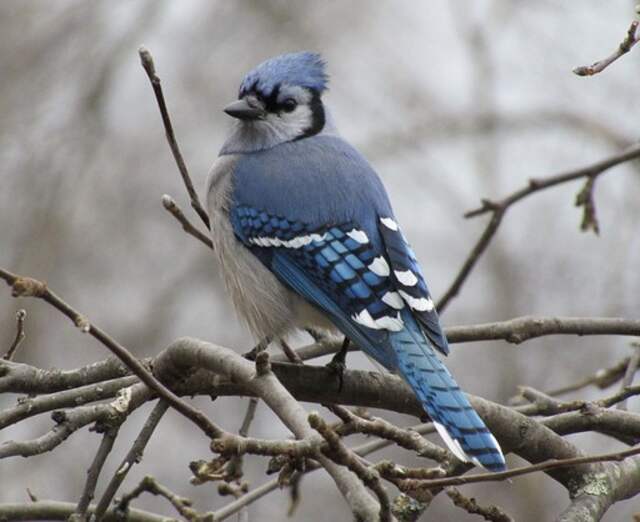
The Blue Jay, or Cyanocitta cristata, is a colorful and striking bird that can be found across eastern and central North America. With their vibrant blue and white plumage and distinctive crest on their heads, they are easily recognizable. Blue Jays are omnivorous and have a varied diet that includes nuts, acorns, insects, and small animals.
They are often seen perched on trees or flying through forests, emitting their loud and characteristic calls. On average, Blue Jays measure around 30 cm in length, with a wingspan of approximately 43 cm, and weigh around 100 grams.
They are known for their intelligence and can mimic the calls of other birds and even some mammals. In the wild, Blue Jays have a lifespan of around 7 years. Their bright colors and lively behavior make them a popular subject among birdwatchers and nature enthusiasts.
Read more: What Attracts Blue Jays to your Yard?(Expert Tips)
Blue Nuthatch
The Blue Nuthatch, or Sitta azurea, is a small bird found in western North America’s pine and mixed-conifer forests. With blue upperparts, white underbelly, and a black stripe through its eye, the Blue Nuthatch is a beautiful sight to behold. Known for its unique feeding behavior of climbing down tree trunks headfirst to forage for insects and seeds.
The Blue Nuthatch makes a nasal “yank yank” sound, which can be heard in the forest. On average, Blue Nuthatches measure around 11 cm in length, with a wingspan of approximately 18 cm and a weight of 10 grams. They form monogamous pairs during breeding season, which occurs in late spring or early summer.
In the wild, Blue Nuthatches have a lifespan of around 4 years, making them a fascinating and sought-after species for birdwatchers and nature enthusiasts.
Read more: How to Attract Nuthatches to your Backyard? Expert Tips!
Eurasian Nuthatch

The Eurasian Nuthatch, or Sitta europaea, is a small bird found throughout Europe and parts of Asia. This species has a distinct blue-grey upperpart and a rusty underpart, with a distinctive black stripe through its eye. Eurasian Nuthatches are known for their unique feeding behavior of climbing down tree trunks headfirst while foraging for insects and seeds.
They have a “twit” or “peep” call which can be heard in the forest. On average, Eurasian Nuthatches measure around 14 cm in length, with a wingspan of approximately 22 cm and a weight of about 20 grams. They form monogamous pairs during breeding season, which takes place from March to July.
In the wild, Eurasian Nuthatches have a lifespan of around 6 years. Birdwatchers and nature enthusiasts are drawn to these birds due to their unique appearance and feeding behavior, which sets them apart from other species.
Indigo Bunting
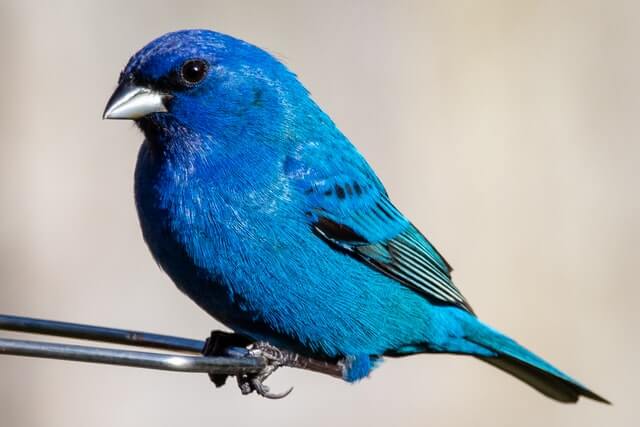
The Indigo Bunting is a small, vibrant bird found across much of North America. The male is a striking blue color, while the female has a more muted brown plumage. Indigo Buntings are known for their beautiful song, which is a rapid and complex series of notes. They typically breed in open woodlands or brushy fields, and their diet consists mainly of seeds and insects.
On average, Indigo Buntings measure around 13 cm in length, with a wingspan of approximately 20 cm, and weigh around 12 grams. During breeding season, males will aggressively defend their territory from other males and court females with their song.
In the wild, Indigo Buntings have a lifespan of around 5 years. Their stunning appearance and melodious song make them a favorite among birdwatchers and nature enthusiasts alike.
Read more: How to Attract Indigo Bunting to your Yard? Expert Tips!
Tree Swallow
Tree Swallows, or Tachycineta bicolor, are small migratory birds found throughout North America. They are known for their iridescent blue-green upperparts and pure white underbelly, making them a beautiful sight to behold in flight. These swallows are insectivorous and feed primarily on flying insects, including mosquitoes and midges, which they catch in mid-air.
They are also cavity nesters and will utilize man-made nest boxes. On average, Tree Swallows measure around 13 cm in length, with a wingspan of approximately 28 cm and an average weight of 20 grams. They form monogamous pairs during breeding season, which occurs from late May to early August.
In the wild, Tree Swallows have a lifespan of around 6 years. Their acrobatic flight and cavity-nesting behavior make them a fascinating and sought-after species for birdwatchers and nature enthusiasts.
Read more: How to Attract Swallows to my Yard? (The Expert’s Guide)
Belted Kingfisher
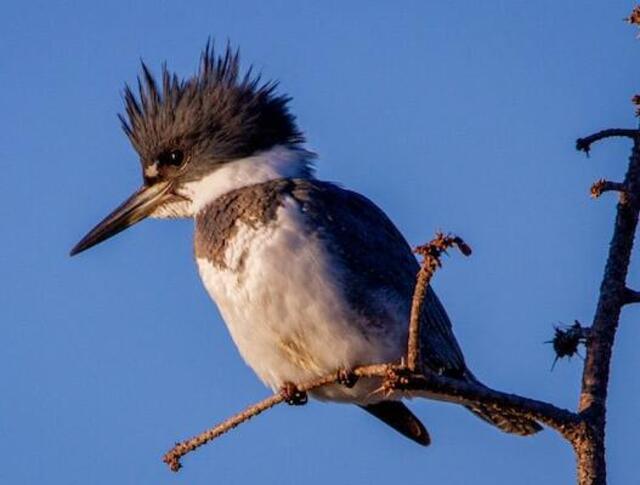
The Belted Kingfisher, or Megaceryle alcyon, is a medium-sized bird found near bodies of water across North America. They are known for their distinctive appearance, with a large head, shaggy crest, and a wide, banded belt across their blue-gray breast. These kingfishers are specialized hunters and feed primarily on fish, but also consume crustaceans, amphibians, and small mammals.
They can often be seen perched on a branch overlooking the water before plunging headfirst to catch their prey. On average, Belted Kingfishers measure around 30 cm in length, with a wingspan of approximately 53 cm and an average weight of 140 grams. They form monogamous pairs during breeding season, which typically begins in late April.
In the wild, Belted Kingfishers have a lifespan of around 6 years. Their unique hunting behavior and striking appearance make them a favorite among birdwatchers and nature enthusiasts.
Read more: 18 Birds That Look Like Kingfishers: Meet The Lookalikes!
Little Blue Heron
The Little Blue Heron, or Egretta caerulea, is a small heron found in coastal areas and wetlands of the southeastern United States, the Caribbean, and Central and South America. They have blue-gray plumage, which distinguishes them from other heron species.
These wading birds feed primarily on fish, but also consume crustaceans, insects, and other small aquatic animals. They stand motionless in the water waiting for prey to approach. On average, Little Blue Herons measure around 60 cm in length, with a wingspan of approximately 90 cm and an average weight of 450 grams.
They form monogamous pairs during breeding season, which occurs from late April to early July. In the wild, Little Blue Herons have a lifespan of around 7 years. Their unique coloration and graceful movements make them a favorite among birdwatchers and nature enthusiasts.
Blue Grosbeak

The Blue Grosbeak, or Passerina caerulea, is a medium-sized songbird found in North and Central America. Males have striking blue plumage with rusty brown wing bars, while females are a more subdued brown color. These birds are seed-eaters and also feed on insects during breeding season.
They can often be seen perched in shrubs and trees or foraging on the ground for food. On average, Blue Grosbeaks measure around 16 cm in length, with a wingspan of approximately 28 cm and an average weight of 36 grams. They form monogamous pairs during breeding season, which typically occurs from late April to early August.
In the wild, Blue Grosbeaks have a lifespan of around 7 years. Their beautiful plumage and sweet song make them a favorite among birdwatchers and backyard bird enthusiasts.
Read more: 40 Blue Grosbeak Interesting Facts (Photos, ID & Info!)
Superb Starling
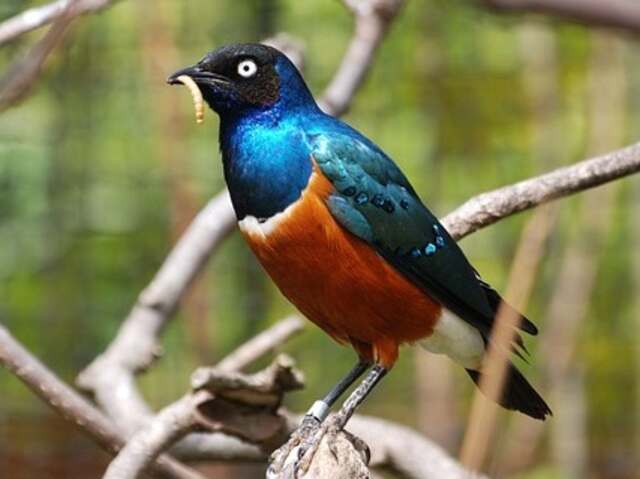
The Superb Starling, scientifically known as Lamprotornis superbus, is a colorful bird found in East Africa, with iridescent blue, green, and black feathers and a rust-colored belly. They are omnivorous, feeding on a variety of insects, seeds, and fruits, and are known to scavenge for food.
On average, Superb Starlings are around 18 cm in length, with a wingspan of 30 cm and a weight of 60 grams. They mate for life and breed from September to May.
In the wild, Superb Starlings live around 5-7 years. They are popular in captive breeding programs and as pets, but it is important to obtain them from reputable sources to ensure their well-being and the conservation of the species in the wild. Their striking colors and lively personalities make them a favorite among bird enthusiasts.
Tickell’s Blue Flycatcher
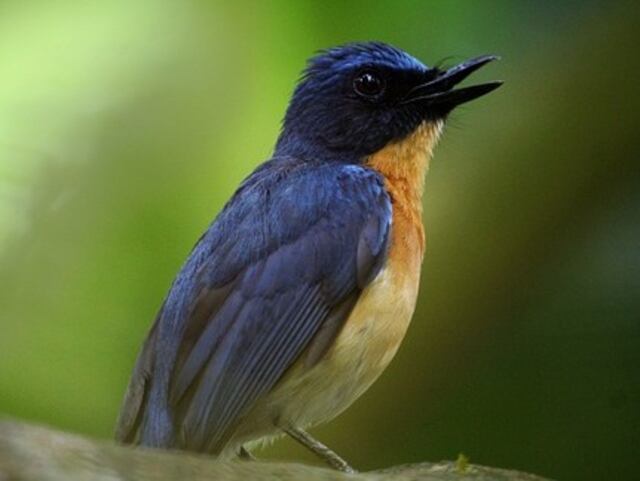
Tickell’s Blue Flycatcher, also known as Cyornis tickelliae, is a small passerine bird found in South and Southeast Asia. It has striking blue plumage on its head, back, and tail, with a rust-colored throat and breast. Tickell’s Blue Flycatcher is typically around 12 cm in length, with a wingspan of approximately 18 cm.
They are insectivorous, feeding on a variety of small insects and spiders. They breed from February to September, with the female building a cup-shaped nest made of grass and moss. Their eggs are pale blue with brown speckles.
Tickell’s Blue Flycatcher is a common resident in many parts of its range, but populations are declining due to habitat loss and degradation. They are popular among bird watchers for their striking appearance and lively behavior.
Blue-bellied Roller
The Blue-bellied Roller, or Coracias cyanogaster, is a colorful bird found in sub-Saharan Africa. It has a distinctive blue-green body with a rusty orange breast and belly, and its wings are blue with black tips. On average, Blue-bellied Rollers are around 32 cm in length, with a wingspan of approximately 50 cm.
They are carnivorous, feeding on a variety of insects, small reptiles, and rodents. Blue-bellied Rollers are monogamous and breed from November to May, with the female laying 2-4 eggs in a cavity or hole in a tree. The eggs are incubated for around 20-22 days.
They are commonly found in savannas and open woodland, and are known for their acrobatic flight and distinctive calls. They are popular among bird watchers for their striking colors and unique behavior.
Black-throated Blue Warbler
The Black-throated Blue Warbler (Setophaga caerulescens) is a small bird species that breeds in the forests of eastern North America. Males have blue upperparts, black face and throat, and white belly, while females have olive-green upperparts and a pale yellowish throat and breast.
They feed mainly on insects and spiders and occasionally consume fruits and seeds. These migratory birds spend the winter in the Caribbean, Central America, and northern South America. They breed from late May to early August in mature deciduous forests with dense understories.
The average size of these warblers is about 12 cm in length, with a wingspan of approximately 20 cm and an average weight of 11 grams. Black-throated Blue Warblers can live up to 8 years in the wild.
Pale Blue Flycatcher
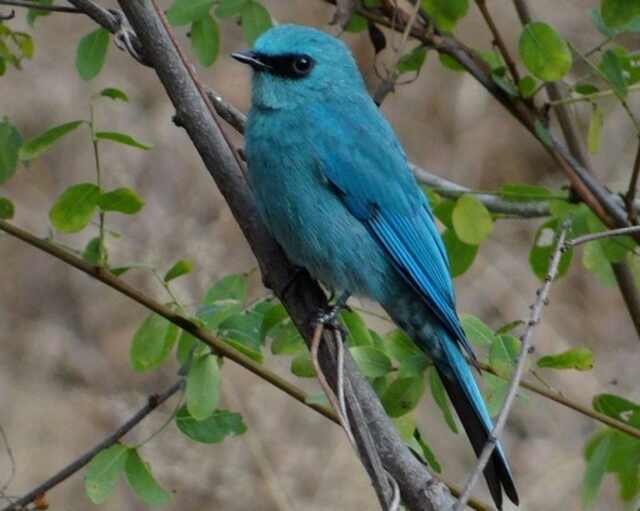
The Verditer Flycatcher (Eumyias thalassinus) is a small bird species found in South and Southeast Asia. They have blue upper bodies and wings, and a black mask around the eyes. Verditer Flycatchers feed on insects and are commonly found in forested habitats, including both evergreen and deciduous forests, as well as in gardens and parks.
Breeding season is from April to June, with 3-4 eggs laid in a cup-shaped nest made of twigs, leaves, and moss. The eggs and young are cared for by both parents, who alternate between incubating and feeding duties.
These birds are small, averaging around 12-14 cm in length with a wingspan of approximately 20 cm and a weight of around 10–15 grams. The lifespan of Verditer Flycatchers is not well known, but they are not considered threatened.
Indian Roller
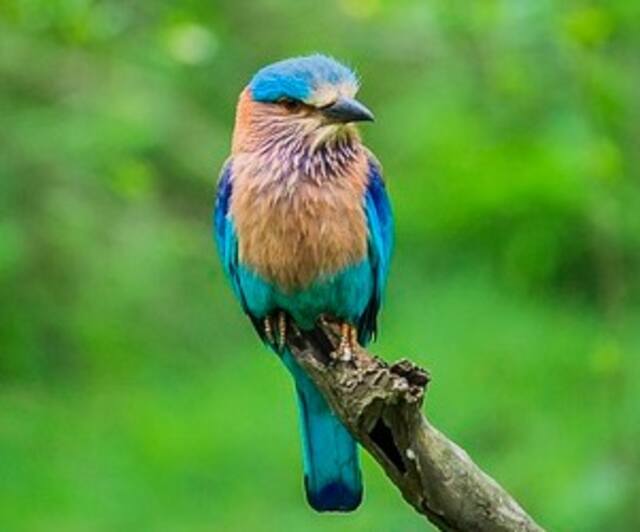
The Indian Roller, also known by its scientific name Coracias benghalensis, is a brightly colored bird species with a distinctive blue-green coloration. It features a big head and lengthy tail feathers. The size of the Indian roller ranges from 32 to 36 cm in length, and its average wingspan is around 52-60 cm.
A typical Indian Roller weighs around 110-150 grams. Its habitat includes open fields, grasslands, scrub forests, agricultural lands and urban areas. These birds feed on insects such as grasshoppers and locusts as well as small reptiles.
They also eat some fruits and seeds during the winter season when their insect food supply is reduced. The lifespan of an Indian Roller in the wild can range between 4 and 8 years; however, in captivity they may live up to 10 years or more.
Cape Starling
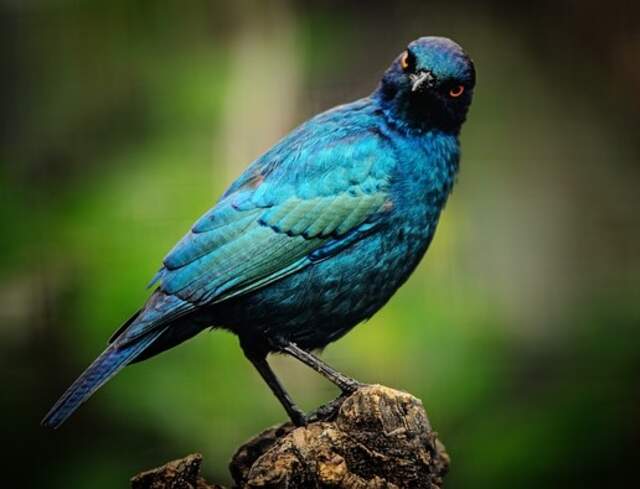
The Cape Starling (Lamprotornis nitens) is a bird species that can be found throughout South Africa. Its scientific name comes from the Greek words for “shining” and “dark”, referring to its beautiful plumage. The Cape Starling has mainly black feathers with purple, blue and green iridescence on its wings, head and nape.
It also has white spots along its wings, which are very distinctive in flight. They are usually between 13-17 cm long, with an average wingspan of 25 cm and an average weight of 32 g. Their natural habitat consists mainly of open grasslands, savanna woodlands, semi-desert scrubland, gardens and suburban areas.
Their diet comprises mostly of insects such as small beetles and moths, as well as fruits like berries or figs. The lifespan for the Cape Starling is about 6-8 years in the wild.
Victoria Crown Pigeon
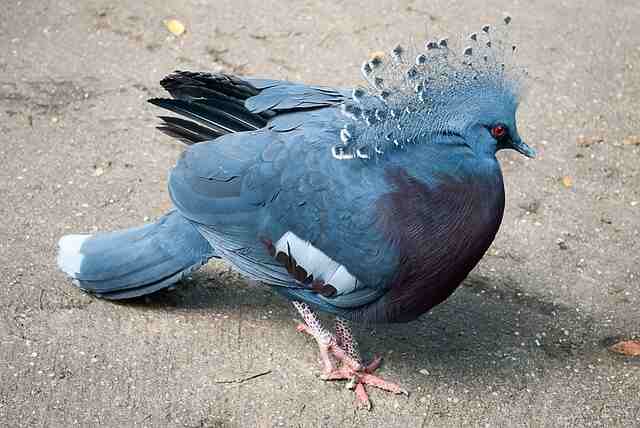
The Victoria Crown Pigeon (Goura victoria) is a large and stunning bird with a unique blue, gray and white coloration. It has a crest of feathers atop its head that give the bird its name. The size of this bird can range from 24-30 inches making them one of the largest pigeons in the world.
Their average wingspan ranges from 43-45 inches and their average weight is 3 pounds 4 ounces. They are native to New Guinea where they inhabit tropical rain forests, swamps, and even cultivated areas.
Its diet consists primarily of fruits, seeds and terrestrial plants found in its natural habitat. The lifespan of these birds in captivity is usually around 10 years while they can live up to 20 years in the wild.
Satin Bowerbird
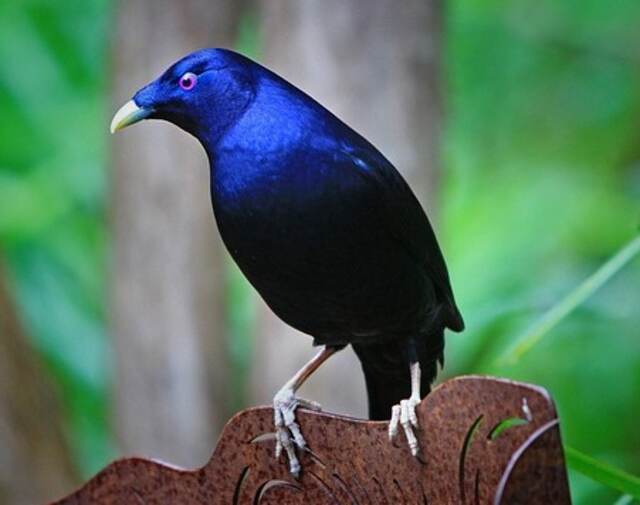
The Satin Bowerbird (Ptilonorhynchus violaceus) is widely distributed throughout Australia. This species has a distinctive coloration which consists of blue, black, and purple feathers that give it its name. The male Satin Bowerbird is especially known for its striking colors, while the female is more muted in comparison.
It has an average length of around 7-8 inches and weighs between 59-98 grams. Its wingspan ranges from 11 to 13 inches. These birds are mostly found in wooded areas such as eucalyptus forests, coastal heaths, and shrublands.
They primarily feed on insects and other arthropods like grasshoppers, caterpillars, spiders, beetles, as well as berries and fruits when available. The average lifespan for these birds can range anywhere from 10-15 years in the wild; however they tend to live longer in captivity.
Superb Fairywren
The Superb Fairywren, also known by its scientific name of Malurus cyaneus, is a small bird found in Australia and New Guinea. It is easily distinguished by its bright blue-black body with patches of brown on the wings and tail. They have a long slender bill and their size varies from 10 to 12cm in length. The average wingspan ranges between 17-21cm while the average weight is 9-16g.
These birds inhabit wet open forests, woodlands and grassy areas. Their diet consists mainly of insects and spiders which they hunt for on the ground or in low shrubs. As they flock together in large groups, individuals will often take turns at keeping watch for predators while others feed.
The lifespan of these birds can range anywhere between 4-7 years depending on environmental factors such as food availability and competition for resources. In captivity, however, they may live up to 11 years old due to optimal living conditions.
Varied Thrush
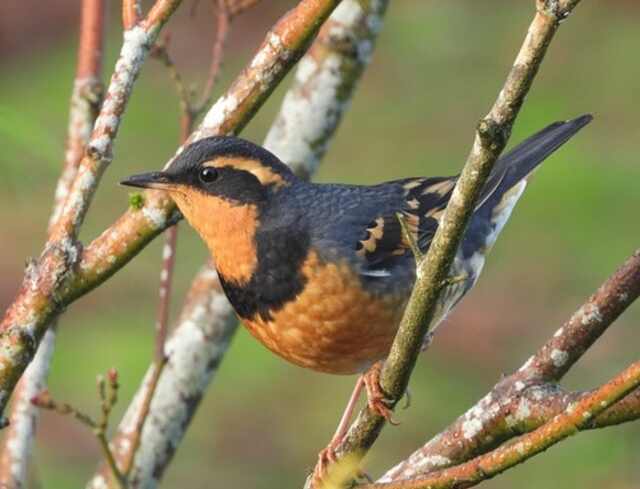
The varied thrush (Ixoreus naevius) is a medium-sized songbird with beautiful, bright plumage. Its scientific name comes from the Latin word for “variegated,” in reference to its striking colors. Typically, varied thrushes are ashy grey on their back, head, and upper breast, with an orange to rust-colored chest and belly.
They also have a dark eye stripe that contrasts sharply with the orange coloring on its face. The average size of this bird is around 9 inches long, with an average wingspan of 13 inches and weight of 1.3 ounces. Varied thrushes typically inhabit areas of coniferous forests or shrublands near water sources such as streams or lakes.
Its diet consists mostly of fruits, insects, and other invertebrates. The typical lifespan of a varied thrush is 5 years in the wild, but can be longer in captivity when cared for properly.
Read more: How to Attract Thrushes to your Garden? (Expert Tips!)
Orange-bellied Flowerpecker

The Dicaeum trigonostigma, commonly known as the Orange-bellied Flowerpecker, belongs to the Dicaeidae family of birds. Its scientific name comes from its triangular shaped bill (trigonostigma). It has predominantly orange underparts, brown upperparts, and yellow to greenish crown. This small bird can reach around 5 centimeters in length and its average wingspan is 8 to 10 centimeters.
The average weight of an adult Orange-bellied Flowerpecker ranges between 8 to 10 grams. Generally found in tropical lowlands, these birds inhabit forests, woodlands, secondary vegetation, mangroves and sometimes urban gardens.
They are known to feed on fruits and insects such as beetles, bugs, aphids and caterpillars. Lifespan of this species tends to be around 4 years in the wild though some individuals have lived up to 12 years in captivity.
Northern Parula
The Northern Parula (Setophaga americana) is a beautiful small migratory warbler. Its predominant colors are deep blue-green on its back and yellow-green below with white patches on each side of their chest. They have an olive colored head, grayish wings and tail, and two distinct white eye stripes that give it a friendly expression.
The Northern Parula typically ranges in size from 4 to 5 inches in length and can have an average wingspan between 7 to 8 inches. On average they weigh less than a quarter of an ounce. These birds usually inhabit wet forests, swamps, and woodlands across the eastern United States and parts of Mexico for most of the year.
It mainly feeds on insects such as caterpillars, spiders, ants, beetles, moths, and other flying invertebrates which makes its diet diverse yet protein rich. The lifespan of this species may range from 3 to 6 years in the wild.
Blue Indian Peafowl
The Blue Peafowl (Pavo cristatus) is a large and colorful bird with a stunning array of hues. Its scientific name literally translates to crest-bearing. The Blue Peafowl is known for its vibrant coloring, which varies from blue to green depending on the angle of light; some show hints of purple, yellow, or white as well. In terms of size, males measure up to 1 meter in length while females are slightly smaller at around 75 cm.
The average wingspan for both genders is about two meters across, and they typically weigh between 4-7 kilograms. These impressive birds are native to India and Sri Lanka and live mainly in forests, grasslands, farmland, and near water sources.
Their diet consists of insects, small mammals or reptiles, fruits, grain and other plant matter. The average lifespan of a healthy Blue Peafowl is 20 years in the wild or longer if kept in captivity.
Read more: What Birds Have The Most Feathers: Understanding Plumage!
Frequently Asked Questions
What breeds of birds are blue?
Several bird species have blue feathers, including blue jays, bluebirds, indigo buntings, mountain bluebirds, and various types of finches. Some species have a mix of blue and other colors, like the blue-and-gold macaw or the blue-crowned motmot.
What are blue colored birds called?
Birds with blue feathers are often called “bluebirds,” but this is just one type of blue-colored bird. Other blue birds include blue jays, indigo buntings, mountain bluebirds, and various types of finches.
What kind of bird is royal blue?
The royal blue bird is actually a color phase of the blue-tailed bee-eater, which is found in Southeast Asia and parts of South Asia. The bird has a bright, iridescent blue body and a long, thin beak for catching insects.
What bird looks like a sparrow but is blue?
The blue grosbeak is a bird species that may resemble a sparrow due to its small size and similar shape. However, the male blue grosbeak has vibrant blue feathers on its head, wings, and back, while the female has a brownish coloration.
What is the rarest blue bird?
The Madagascar pochard is considered one of the rarest birds in the world, and it has striking blue feathers on its wings and back. The species was thought to be extinct until a small population was discovered in a remote area of Madagascar in 2006.
What is the prettiest blue bird?
This is subjective, as beauty is in the eye of the beholder. However, many people consider the male peacock to be one of the most beautiful birds with blue feathers, due to its large, colorful tail feathers.
What is the beautiful blue bird?
Again, beauty is subjective, but some birds with striking blue feathers include the victoria crown pigeon, blue jay, indigo bunting, and blue-crowned motmot.
What are the three blue birds called?
This is a bit ambiguous, as there are many bird species with blue feathers. However, three commonly known species of blue birds in North America are the eastern bluebird, western bluebird, and mountain bluebird.
What does it mean when a blue bird visits you?
In many cultures, blue birds are considered a symbol of happiness, joy, and good luck. So if a blue bird visits you, it could be seen as a positive sign or an indication of good things to come. However, it’s important to remember that birds are wild animals, and their behavior is not always predictable.
What is a small dark blue bird?
A small dark blue bird is likely the Indigo Bunting. It is a sparrow-sized bird with a bright blue plumage in males and a brownish-gray color in females. They are found in the eastern and central parts of North America, typically in brushy areas near fields and forests.
What is the blue bird that looks like a finch?
The blue bird that looks like a finch is likely the Blue Grosbeak. It has a similar body shape and beak to a finch but with bright blue plumage in males and brownish coloring in females. Blue Grosbeaks are found in the southern United States and Mexico and prefer habitats such as fields, open woods, and brushy areas.
What bird is large and blue?
The largest blue bird is likely the Hyacinth Macaw. It is a large parrot with bright blue feathers and can reach up to 40 inches in length. It is native to South America and lives in tropical forests and savannas.
Are there blue finches?
Yes, there are blue finches. The most common one is the Blue Grosbeak, but there is also the Indigo Bunting and the Lazuli Bunting, which are often mistaken for finches due to their similar size and beak shape.
What is a small turquoise bird?
A small turquoise bird is likely the Turquoise-browed Motmot. It is a small bird found in Central and South America and is known for its distinctive turquoise coloring on its head and back.
How many types of blue birds are there?
There are several types of blue birds, including the Indigo Bunting, Blue Grosbeak, Blue Jay, Mountain Bluebird, and Eastern Bluebird, among others. The exact number of blue bird species varies depending on classification, but there are over 100 species of birds with blue plumage.
What bird is blue with a black head?
The bird that is blue with a black head is likely the Steller’s Jay. It is a medium-sized songbird found in western North America, and its striking blue and black coloring is a distinctive characteristic.
Are there any truly blue birds?
Yes, there are truly blue birds. The Blue Jay, Mountain Bluebird, and various species of blue jays and thrushes have blue plumage that is not mixed with any other color.
What is the blue and gold bird called?
The blue and gold bird is called the Blue-and-yellow Macaw. It is a large parrot with bright blue and yellow feathers and is native to South America.
What is the blue bird that looks like a robin?
The blue bird that looks like a robin is likely the Eastern Bluebird. It is a small thrush with bright blue plumage on its back and a rusty-red coloring on its chest. It is commonly found in open woodlands and fields throughout the eastern United States.
How rare is a blue finch?
Blue finches, also known as Blue Grosbeaks, are not as rare as some other blue birds but are not as commonly seen as well. They can be found in the Southern and Eastern regions of the United States.
These birds have a blue head, back, and tail, with rusty brown underparts. They can be identified by their thick, conical bills, and stout bodies.
How do I identify a blue bird?
There are many types of blue birds, but they can generally be identified by their blue feathers. The shade of blue can vary from light sky blue to deep royal blue. Some blue birds, like blue jays and scrub jays, have crest feathers on their heads.
Other blue birds, like bluebirds, have reddish-brown breasts and bellies. Some blue birds, like indigo buntings, have distinctive beaks or wing bars. It’s important to observe their behavior and habitat to make a proper identification.
What does a blue mockingbird look like?
Blue mockingbirds are large, slender birds with a long tail and a slender bill. They have a slate-blue head and back, with a white underbelly and black wings and tail. They can be found in Mexico and Central America and are rare to see. They are often found in dense forests and thickets, where they feed on insects and fruit.
What is the blue bird that looks like a crane?
The blue bird that looks like a crane is the Blue Crane, also known as the Stanley Crane. They are native to South Africa and are the country’s national bird. Blue Cranes are large birds with long necks and legs, and they have a slate-blue plumage with white cheeks and a red patch on their forehead. They are known for their distinctive dance displays during breeding season and can often be found in open grasslands and wetlands.
What does a Jaeger bird look like?
Jaeger birds, also known as skuas, are seabirds found in the Arctic and Subarctic regions. They have a bulky body, a hooked beak, and long wings. They are generally dark in color, with black or brown plumage, and can have white or light-colored markings on their wings. Their notorious reputation stems from their aggressive behavior, which involves harassing other seabirds and pilfering their food.
What kind of bird is teal in color?
The common teal is a small dabbling duck that is found in the Northern Hemisphere. The male has a distinctive greenish-blue head and a rusty-red patch on its breast. The female has a mottled brown plumage with a green patch on its wing. They are often found in wetlands and marshes, and their diet consists of aquatic plants, insects, and small invertebrates.
What bird has a bright blue back and red chest?
The Eastern Bluebird has a bright blue back, with a rusty-red breast and white belly. They are found throughout the Eastern and Central regions of North America and are cavity nesters. They can often be seen perched on fences and power lines, scanning for insects and small prey. Eastern Bluebirds are a favorite of bird enthusiasts and are often attracted to backyards with nest boxes and mealworms.
What does an indigo blue bird look like?
Indigo Buntings are small birds with a bright blue plumage and a short tail. The male has a distinctive blue color, while the female is brownish with a slight blue tint. They are found in the Eastern and Central regions of North America and are known for their sweet, warbling songs. Indigo Buntings can often be seen perched on the tops of shrubs and bushes, feeding on seeds and insects.
What small bird has a blue crown?
The Blue-crowned Parakeet is a small parrot that is native to South America. It has a green body with a bright blue crown on top of its head, making it easily identifiable. These parakeets are popular pets and can often be seen in flocks in urban areas.
What is an aqua bird?
“Aqua bird” is not a specific term used to describe a particular bird species. However, some birds have aqua or turquoise-colored plumage, such as the Azure Kingfisher, which is a small bird found in Australia and New Guinea. It has bright blue-green feathers on its back, wings, and head, making it a stunning sight to behold.
What is a bluish gray songbird?
The Eastern Bluebird is a small songbird that is found in eastern North America. The male has a bright blue back, wings, and head, while the female has a bluish-gray back and wings with a reddish-brown breast. They are cavity nesters and can often be found nesting in birdhouses.
What is the most common blue bird?
The Eastern Bluebird (Sialia sialis) is the most common blue bird in North America. They are found in open woodlands, fields, and meadows in the eastern and central parts of the United States. Eastern Bluebirds are cavity nesters, and they are often seen perched on fence posts or other open perches while scanning the ground for insects and other small prey.
What birds are often blue?
There are several species of birds that are often blue, including Blue Jays, Indigo Buntings, Mountain Bluebirds, and Western Bluebirds. Other birds that may have blue in their plumage include Blue Grosbeaks, Blue-winged Teals, and Blue-throated Hummingbirds. Blue is a common color in the plumage of many bird species, and it can be found in a wide range of shades and hues.
What color is a female blue bird?
Female blue birds, such as female Eastern Bluebirds, have similar plumage to males but are generally duller in color. Female Eastern Bluebirds have a grayish-blue back and wings with a reddish-brown breast and white belly. Their coloration helps to camouflage them while nesting and caring for their young.
What is a blue bird that looks like a cardinal?
The Blue Grosbeak (Passerina caerulea) is a blue bird that can be mistaken for a cardinal. The males have a bright blue head, back, and wings with rusty-brown underparts, while the females are brown with a blue-gray wash on the head, wings, and tail. Blue Grosbeaks are found in the southern and central parts of the United States, where they inhabit brushy areas and open woodlands.
What bird looks like a blue jay but bigger?
The Steller’s Jay (Cyanocitta stelleri) is a bird that looks similar to a Blue Jay but is larger in size. They have a dark blue head and body with a black crest on the head and a black patch on the throat. Steller’s Jays are found in the western parts of North America, where they inhabit coniferous forests and wooded areas. They are known for their raucous calls and their ability to mimic other bird species.
What kind of bird looks like a blue jay but is black?
The bird that looks like a blue jay but is black is the Black-headed Grosbeak. It has a black head and wings, with a bright orange and black body. It is commonly found in western North America and can be easily identified by its distinct coloration and large, conical beak.
What is the rarest blue bird?
The rarest blue bird is the Spix’s Macaw, also known as the Little Blue Macaw. It is native to Brazil and was considered extinct in the wild until a small population was rediscovered in 2016. The bird is critically endangered due to habitat loss and illegal poaching for the pet trade. Conservation efforts are ongoing to save the remaining birds and restore their natural habitat.
What bird is blue but not a bluebird?
The Blue Jay is a bird that is blue but not a bluebird. It has a distinct blue and white coloring, with a crest on its head. They are common in North America and are known for their loud calls and intelligent behavior. The Blue Jay is a member of the Corvidae family, which includes crows and ravens.
What is a solid blue bird in North America?
The solid blue bird in North America is the Blue Grosbeak. It has a vibrant blue coloration with a stout, conical bill and a thickset body. They are common in the southern United States and Mexico and are often found in open fields and along the edges of woods. The male Blue Grosbeak has a distinct song and is known for its territorial behavior during mating season.
Conclusion
In conclusion, blue birds are some of the most stunning creatures found in the natural world. Their brilliant blue feathers have captured the attention and imagination of bird enthusiasts and casual observers alike.
This list of 30 breathtaking blue birds is just a small sample of the many species that exist worldwide. Whether you’re a seasoned birder or simply appreciate the beauty of nature, we hope this visual feast has left you in awe and inspired you to further explore the fascinating world of blue birds.


